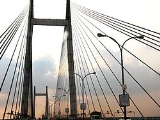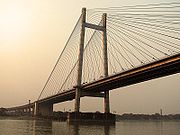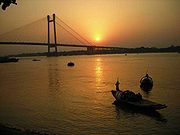
Vidyasagar Setu
Encyclopedia
Vidyasagar Setu, also known as the Second Hooghly Bridge, is a bridge
over the Hooghly River in West Bengal
, India
. It links the city of Kolkata
to Howrah. The bridge is a toll bridge
for all vehicles. At a total length of 822.96 m, it is the longest cable-stayed bridge in India and one of the longest in Asia. It was built at a cost of Rs
388 crore
s and commissioned on October 10, 1992. Its construction was a joint effort of the Public Sector Undertakings and private firms, under the control of the Hooghly River Bridge Commissioners.
It was the second bridge to be built across the Hooghly River, after the Howrah Bridge
(also known as Rabindra Setu) 12 kilometres (7.5 mi) to its south was built in 1943. The bridge is named after the 19th century Bengali
educationist reformer Pandit Ishwar Chandra Vidyasagar
.
(Bombay), Delhi
and Chennai
(Madras) through the national highways located close to the bridge.
The foundation stone for the bridge was laid by Indira Gandhi
on May 20, 1972. The actual work on the cable-stayed (then the longest span bridge of this type of bridge in the world) started on July 3, 1979, with the construction of the well curb on the Calcutta
bank end. The bridge was commissioned on October 10, 1992, when it was the first cable-stayed bridge in India, the largest in Asia and the third largest in the world. It thus took 20 years to complete, although seven of those years saw no construction.
 The bridge is a multi cable-stayed bridge (121 cables) with a fan arrangement built on steel pylons 127.62 metres (418.7 ft) in height. It has a composite steel-reinforced concrete deck having two carriage ways with a total width of 35 metres (114.8 ft), with 3 lanes each way and with a foot path of 1.2 metres (3.9 ft) on either side. The deck is over the main span of 457.2 metres (1,500 ft) length and two side spans of 182.88 metres (600 ft) each, supported by parallel wire cables. The bridge was designed by Schlaich Bergermann & Partner
The bridge is a multi cable-stayed bridge (121 cables) with a fan arrangement built on steel pylons 127.62 metres (418.7 ft) in height. It has a composite steel-reinforced concrete deck having two carriage ways with a total width of 35 metres (114.8 ft), with 3 lanes each way and with a foot path of 1.2 metres (3.9 ft) on either side. The deck is over the main span of 457.2 metres (1,500 ft) length and two side spans of 182.88 metres (600 ft) each, supported by parallel wire cables. The bridge was designed by Schlaich Bergermann & Partner
, checked by Freeman Fox & Partners and Bharat Bhari Udyog Nigam Limited. Construction was carried out by Gammon India
Ltd.
in Bangalore
. Bearings used in vertical and horizontal directions consisted of Elastomet bearings (with grouted collars in four segments) at the two end piers and horizontal bearings at the two middle piers to achieve stability against lateral movement. Maurier Shone Expansion joints are provided to allow for ±400 millimetres (15.7 in) at the free ends. Fixed end slab seal type expansion joint ±115 millimetres (4.5 in) is used for the fixed ends. Other essential paraphernalia provided in the bridge structure are the handrails, lightening arresters, crash barriers, gas service support structures, telephone and electric lines, lifts inside pylon structures and maintenance gantry.
 The basic approach followed was by tackling the two side spans using erection cranes. The bridge elements were erected with a Ring Crane of 50-tonne capacity located on the ground with a feeding track positioned on the deck. While trestles on the Calcutta end were founded on raft foundations, those on the Howrah end were founded over large diameter piles. During erection, side sway of the deck was countered by providing suitable temporary bracings.
The basic approach followed was by tackling the two side spans using erection cranes. The bridge elements were erected with a Ring Crane of 50-tonne capacity located on the ground with a feeding track positioned on the deck. While trestles on the Calcutta end were founded on raft foundations, those on the Howrah end were founded over large diameter piles. During erection, side sway of the deck was countered by providing suitable temporary bracings.
A specially designed and manufactured Crane of 45-tonne capacity of self-climbing type, which bridged the 38.4 metres (126 ft) space pylon legs, fully facilitated erection of all pylons.
Accurate positioning and setting of the inclination of the cables was ensured by the saddles fixed at the anchor points of main girders and the pylon head.
Piers 1 and 4 were provisioned with "four numbers holding down cables in each cable plane," and tensioned to 555 MT to produce vertical compression on the bearings. Measurement of tension was done with a load measuring device fixed on each cable. Settlement measurements under total load conditions of the bridge were ensured through watering and dewatering of the wells of piers 2 and 3 that supported the pylons.
Bridge
A bridge is a structure built to span physical obstacles such as a body of water, valley, or road, for the purpose of providing passage over the obstacle...
over the Hooghly River in West Bengal
West Bengal
West Bengal is a state in the eastern region of India and is the nation's fourth-most populous. It is also the seventh-most populous sub-national entity in the world, with over 91 million inhabitants. A major agricultural producer, West Bengal is the sixth-largest contributor to India's GDP...
, India
India
India , officially the Republic of India , is a country in South Asia. It is the seventh-largest country by geographical area, the second-most populous country with over 1.2 billion people, and the most populous democracy in the world...
. It links the city of Kolkata
Kolkata
Kolkata , formerly known as Calcutta, is the capital of the Indian state of West Bengal. Located on the east bank of the Hooghly River, it was the commercial capital of East India...
to Howrah. The bridge is a toll bridge
Toll bridge
A toll bridge is a bridge over which traffic may pass upon payment of a toll, or fee.- History :The practice of collecting tolls on bridges probably harks back to the days of ferry crossings where people paid a fee to be ferried across stretches of water. As boats became impractical to carry large...
for all vehicles. At a total length of 822.96 m, it is the longest cable-stayed bridge in India and one of the longest in Asia. It was built at a cost of Rs
Rupee
The rupee is the common name for the monetary unit of account in India, Sri Lanka, Nepal, Pakistan, Mauritius, Seychelles, Maldives, and formerly in Burma, and Afghanistan. Historically, the first currency called "rupee" was introduced in the 16th century...
388 crore
Crore
A crore is a unit in the Indian number system equal to ten million , or 100 lakhs. It is widely used in India, Bangladesh, Nepal, and Pakistan....
s and commissioned on October 10, 1992. Its construction was a joint effort of the Public Sector Undertakings and private firms, under the control of the Hooghly River Bridge Commissioners.
It was the second bridge to be built across the Hooghly River, after the Howrah Bridge
Howrah Bridge
The Howrah Bridge is a cantilever bridge that spans the Hooghly River in West Bengal, India. Commissioned in 1943, the bridge was originally named the New Howrah Bridge, because it links the city of Howrah to its twin city, Kolkata . On 14 June 1965 it was renamed Rabindra Setu, after Rabindranath...
(also known as Rabindra Setu) 12 kilometres (7.5 mi) to its south was built in 1943. The bridge is named after the 19th century Bengali
Bengali people
The Bengali people are an ethnic community native to the historic region of Bengal in South Asia. They speak Bengali , which is an Indo-Aryan language of the eastern Indian subcontinent, evolved from the Magadhi Prakrit and Sanskrit languages. In their native language, they are referred to as বাঙালী...
educationist reformer Pandit Ishwar Chandra Vidyasagar
Ishwar Chandra Vidyasagar
Ishwar Chandra Vidyasagar CIE , born Ishwar Chandra Bandopadhyaya , was an Indian Bengali polymath and a key figure of the Bengal Renaissance....
.
History
After India became independent in 1947, there was rapid growth not only in commercial activity but also in population. The only link across the Hooghly River, the Howrah Bridge between Howrah and Kolkata was subject to very large traffic pressure which necessitated planning for a new bridge across the river so that it could connect to the major cities of MumbaiMumbai
Mumbai , formerly known as Bombay in English, is the capital of the Indian state of Maharashtra. It is the most populous city in India, and the fourth most populous city in the world, with a total metropolitan area population of approximately 20.5 million...
(Bombay), Delhi
Delhi
Delhi , officially National Capital Territory of Delhi , is the largest metropolis by area and the second-largest by population in India, next to Mumbai. It is the eighth largest metropolis in the world by population with 16,753,265 inhabitants in the Territory at the 2011 Census...
and Chennai
Chennai
Chennai , formerly known as Madras or Madarasapatinam , is the capital city of the Indian state of Tamil Nadu, located on the Coromandel Coast off the Bay of Bengal. Chennai is the fourth most populous metropolitan area and the sixth most populous city in India...
(Madras) through the national highways located close to the bridge.
The foundation stone for the bridge was laid by Indira Gandhi
Indira Gandhi
Indira Priyadarshini Gandhara was an Indian politician who served as the third Prime Minister of India for three consecutive terms and a fourth term . She was assassinated by Sikh extremists...
on May 20, 1972. The actual work on the cable-stayed (then the longest span bridge of this type of bridge in the world) started on July 3, 1979, with the construction of the well curb on the Calcutta
Kolkata
Kolkata , formerly known as Calcutta, is the capital of the Indian state of West Bengal. Located on the east bank of the Hooghly River, it was the commercial capital of East India...
bank end. The bridge was commissioned on October 10, 1992, when it was the first cable-stayed bridge in India, the largest in Asia and the third largest in the world. It thus took 20 years to complete, although seven of those years saw no construction.
Features

Schlaich Bergermann & Partner
Schlaich Bergermann & Partner, based in Stuttgart, Germany is a world-renowned structural engineering firm. It was founded in 1980 by Jörg Schlaich and Rudolf Bergermann.-Projects:* 1978-1992: Vidyasagar Setu , Kolkata, India...
, checked by Freeman Fox & Partners and Bharat Bhari Udyog Nigam Limited. Construction was carried out by Gammon India
Gammon India
Gammon India Limited is the largest civil engineering construction company in India. Headquartered in Mumbai, it was founded in 1922 by John C...
Ltd.
Design
The design features of the bridge differ slightly from the bridges that are of live load composite construction. The difference is in the dead load design concept adopted for this bridge, while concreting the side spans with support provided by the intermediate trestle. The deck is designed with a grid structure with girders; one set of girders at the end and another in the middle braced by girders spaced at 4.2 metres (13.8 ft) centre to centre on average are provided. In this approach, the weight of green concrete on the deck is borne by the "composite action of the deck grid." The pylons, which are 128 metres (419.9 ft) in height (up to the head), are designed as free standing portals. They are provided with two cross portal members, one at the bottom and another at the top below the pylon head. The deck is connected to the end piers by bolts embedded in the chambers of the piers. The total weight of structural steel used in the bridge is 13,200 metric tonnes. The bridge was also subject to prototype wind tunnel tests at the Indian Institute of ScienceIndian Institute of Science
Indian Institute of Science is a research institution of higher learning located in Bangalore, India. It was established in 1909.-History:After a chance meeting between Jamsetji N...
in Bangalore
Bangalore
Bengaluru , formerly called Bengaluru is the capital of the Indian state of Karnataka. Bangalore is nicknamed the Garden City and was once called a pensioner's paradise. Located on the Deccan Plateau in the south-eastern part of Karnataka, Bangalore is India's third most populous city and...
. Bearings used in vertical and horizontal directions consisted of Elastomet bearings (with grouted collars in four segments) at the two end piers and horizontal bearings at the two middle piers to achieve stability against lateral movement. Maurier Shone Expansion joints are provided to allow for ±400 millimetres (15.7 in) at the free ends. Fixed end slab seal type expansion joint ±115 millimetres (4.5 in) is used for the fixed ends. Other essential paraphernalia provided in the bridge structure are the handrails, lightening arresters, crash barriers, gas service support structures, telephone and electric lines, lifts inside pylon structures and maintenance gantry.
Construction methodology

Pylons
Pylons made of 4×4 m steel boxes of riveted construction were raised on the two side spans of the bridge, one set on the Calcutta side and the other on the Howrah side pylons; on the Calcutta side of the bridge, six pylons were installed using 75 MT and 50 MT cranes, while on the Howrah end, a single 50 MT crane was used. Anchorage of the pylon with the base of piers was effected through Dydwidag rods duly anchored in the piers. The first base element of the pylon was a grouted bed (non-shrink type) followed by the next successive tiers.A specially designed and manufactured Crane of 45-tonne capacity of self-climbing type, which bridged the 38.4 metres (126 ft) space pylon legs, fully facilitated erection of all pylons.
Main span
The method followed for constructing the main span of the bridge was to erect it from both ends, as cantilevers. A deck crane was used for this erection. Cables were erected from the four pylon heads with the help of 32 MT hoist frames which were mounted on top of each pylon; sheave blocks, winches and snatch blocks were used to facilitate the lifting. Cables inside the pylons were stressed with jacks (with help of accessories such as pulling strand, and male and female strand sockets). Pressure grouting filled the voids between the wire and the HDPE tubes. A two-tonne tower crane, fixed inside the pylons, facilitated lifting of the cables into position.Accurate positioning and setting of the inclination of the cables was ensured by the saddles fixed at the anchor points of main girders and the pylon head.
Piers 1 and 4 were provisioned with "four numbers holding down cables in each cable plane," and tensioned to 555 MT to produce vertical compression on the bearings. Measurement of tension was done with a load measuring device fixed on each cable. Settlement measurements under total load conditions of the bridge were ensured through watering and dewatering of the wells of piers 2 and 3 that supported the pylons.
Final act
The final act of completing the bridge was of "matching the level and length of the bridge at the centre." This was initially achieved by concreting the slabs to reduce the upward deflection before joining. Temperature measurements were taken to assist in assessing the "length of longitudinal girder at the centre." Three types of deviations were recorded: the level difference in the vertical direction in adjoining span, the deviation in the horizontal direction, and the central girder’s length. Matching of the length was achieved by applying a thrust force by jacking on the free side of the Howrah end of the bridge which allowed for backward movement due to temperature to ensure that the central part of the bridge achieved a connection. Other methods adopted to reduce the final difference in level were horizontal and vertical jacking with jacks fixed on girders.See also
- List of largest cable-stayed bridges
- List of longest bridges in the world
- List of longest bridges above water in India
External links
- Hooghly River Bridge Commissioners Website
- The pictures of the bridge and its surroundings

